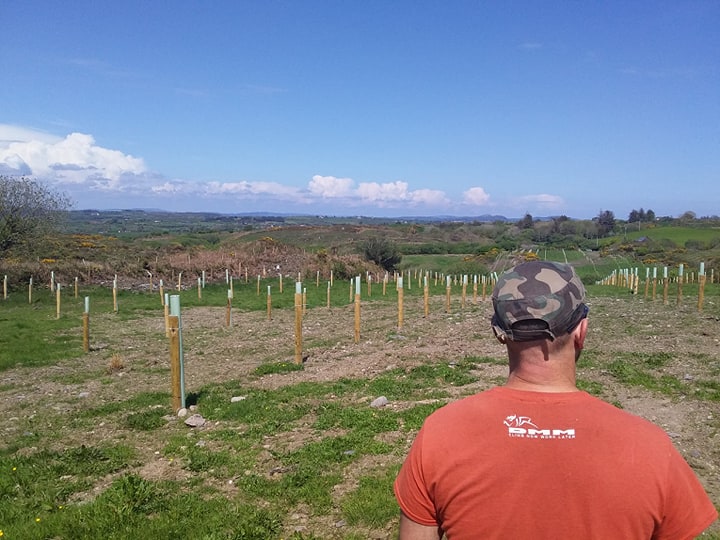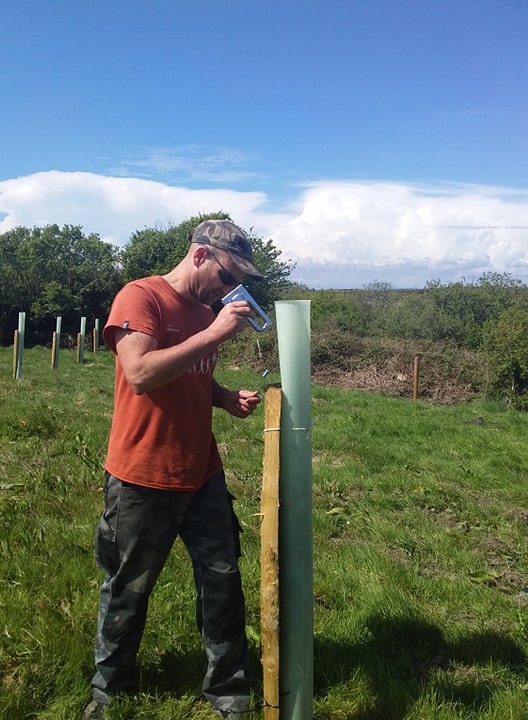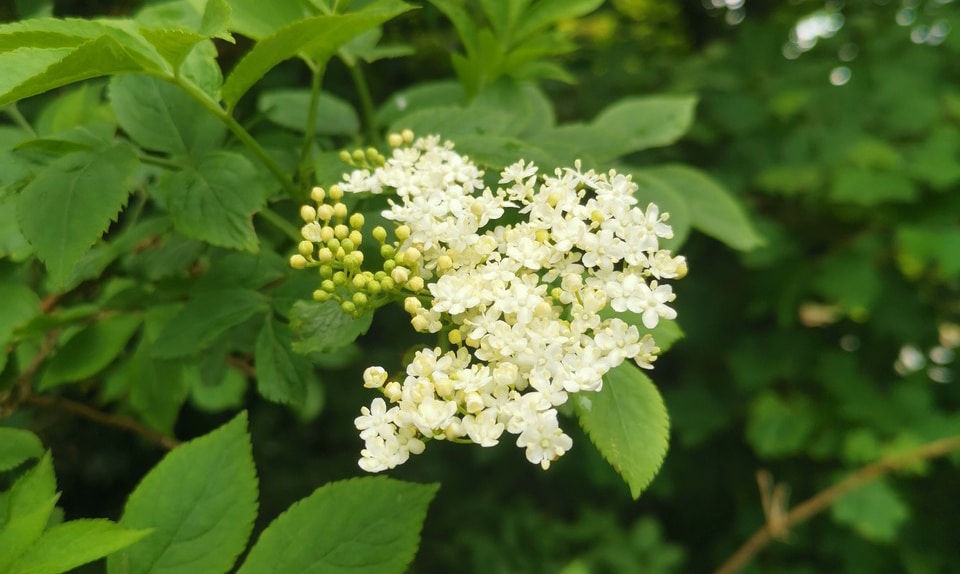Agroforestry is the practice of combining forestry and agriculture in a mutually beneficial way. West Cork agroforester Rossa Gibbons talks to Moze Jacobs about his passion for trees and the benefits of planting on agricultural land.
Trees are long-lived. (The oldest known individual specimen is almost 5,000 years old). So maybe it is no accident that agroforester Rossa Gibbons (43) speaks in centuries when discussing his first plantation and its problems. “The oaks that are here now – although they are growing fine – are forking and growing every which way. That will disadvantage my great-grandchildren. Their end crop will be just firewood. Whereas, if they would have quality timber in 110 years’ time, it could be used to make barrels for our local distillery, for example.” Agroforestry is often presented as some new-fangled branch of agriculture. Of course it is anything but. Once upon a time, most of Ireland (and the rest of the world) was covered in forest as far as the eye could see and trees surrounded all fields.
Fast forward. A devastating change takes place under the Tudors, as Elizabeth I orders the destruction of all woods to deprive the Irish resistance (and the wolves) of shelter. By 1711, writes John Wilson Foster in ‘Nature in Ireland: A Scientific and Cultural History’, “Ireland … had become a treeless wilderness and a net importer of timber.”
“Ireland has the lowest forest cover of all European countries: approximately 11 per cent compared to a European average of well over 30 per cent,” mentions Teagasc on its website.
Now Ireland aims to plant 440 million trees by 2040 (30 per cent broad leaves and 70 per cent conifers, whereas spruce plantations are being described as “ecological dead zones”).
The Irish Department of Agriculture has been providing grants for the planting and maintenance of trees for years. Rossa Gibbons, born in Dublin but raised in West Cork, planted the aforementioned oaks 18 years ago. “I got my first Afforestation Premium grant when I was 25. I was quite naïve at the time and got really excited when I learned I could plant hardwoods such as oak. Prior to that, only soft wood like sitka spruce had been approved. I needed a contracting company to do the planting and to apply for the grant. If you want to do it yourself, you need a degree in forestry, which I’m now studying for in Bangor, Wales. A really good online course. In hindsight, I am unhappy with the provenance of the oak. They cut corners by buying poor stock.”
Rossa is passionate about trees and built his own house on the top of a hill near Lough Hyne, close to Skibbereen, using different types of wood. “All locally sourced. I was landscaping in my 20s and I planted 80 trees around my house. No, I didn’t mind felling them. I don’t like cutting down gorgeous big mature oaks and beeches, but if you plant a tree expressly for construction purposes, I think it is great to have the timber to hand.”
He has been planting trees on his land (which comprises 13 hectares) in stages. A substantial amount five years ago while his latest saplings went into the ground earlier this year, in March. These are now protected with plastic tree guards. A mix of (native) trees that include oak, birch, hazel, walnut.
“You are allowed to have 15 per cent fruit and nut trees, maybe even 20 per cent, under the conditions of the grant,” he explains. They are planted on a rolling hill in dead straight lines. “The trees are set apart at a considerable distance, so you can still bring in a big tractor and trailer to cut silage or hay.” A small flock of sheep grazes between them. “They’re not mine but I’ll be getting my own sheep later, Shropshire, a special variety from England that I can rotate into my five-year old woodland. They won’t damage the trees. Instead, they will help establish them and add to the nutrient value of the soil. Yields increase by 40 per cent in many cases. I have also set up a coppice rotation system and am selling as much firewood as I can manage.”
Rossa thinks the interest among farmers in agroforestry may be on the up. “There is a curiosity at least and perhaps also a slow cultural shift.”
As well as farming, he is working as a tree surgeon. To make a living as his trees mature, but that is not the only reason. “I am fascinated by trees. In a scientific sense but there are also emotional connections. Trees give us a lovely sense of space. And wood is an amazing material; a lovely natural resource. Its value changes as you work with it. I look with great respect at beams on the back of a truck or in a hardware shop as I know how much effort has gone into getting it there.”
Recognised as native trees are the species that were in the country over 10,000 years ago when Ireland became an island, cut off from Britain and mainland Europe as the sea levels rose after the last Ice Age. This gave broadleaf trees such as oak, ash, birch, willow and three types of conifer – Scots pine, yew and juniper – plenty of time to build up intricate relationships with all sorts of lichen (fungi and algae) that provide food and shelter to invertebrates which, in turn, feed a range of other creatures. A single ash tree can support 536 lichen species that may appear like mere blobs of colour to the human eye. Latecomers such as beech and sycamore can still do a lot for wildlife – but not as much.
“Native trees,” says Rossa, “boost biodiversity, which offers more disease resistance to the forest and to grazing animals. Lamb mortality can decrease by up to 50 per cent in an agroforestry scheme. What I have on my land is a mix of native and non-native trees, like the walnut plus about 15 per cent high-quality conifers such as cypress and cedar that will have to be thinned out eventually in any case to make space for other trees.”
If you are interested in learning more about agroforestry check out The Wild Wednesday Webinars, a series of webinars on the themes of farming, nature and heritage. Co-hosted by the Burrenbeo Trust and the Farming for Nature initiative, they take place every Wednesday between 8 and 9pm until the end of May.
If you want to plant native trees in your own land or garden these can be sourced through Trees on the Land, Ballineen, https://www.treesontheland.com/.
If you would like to be included on their mailing list for notification about future planting projects or have any other questions, email info@treesontheland.com.
The Clonakilty Tree Planting Project will be looking for people who want to plant trees in their garden or on their land (in or near Clonakilty) in the autumn or whenever the restrictions are lifted enough to make this possible.
Contact Dairmaid Creggan, mr_compass@hotmail.com if you wish to be updated on developments.
Sustainable Skibbereen have a tree-planting project that will likely continue in the autumn or spring, please email Brian Granaghan, contact@sustainableskibbereen.com
West Cork Environmental Action in Bandon is interested in working with people on sustainable tree planting projects when this will again be possible. Contact Anna Roycroft, wceabandon@gmail.com
For information about tree planting projects in Golleen please contact Matt Mills, matt@goleenharbour.ie
If you are wondering about grants and considering whether you want to go down the agroforestry road, you can contact Eugene Curran, forestry inspector at the Department of Agriculture, who will be happy to answer your questions.







